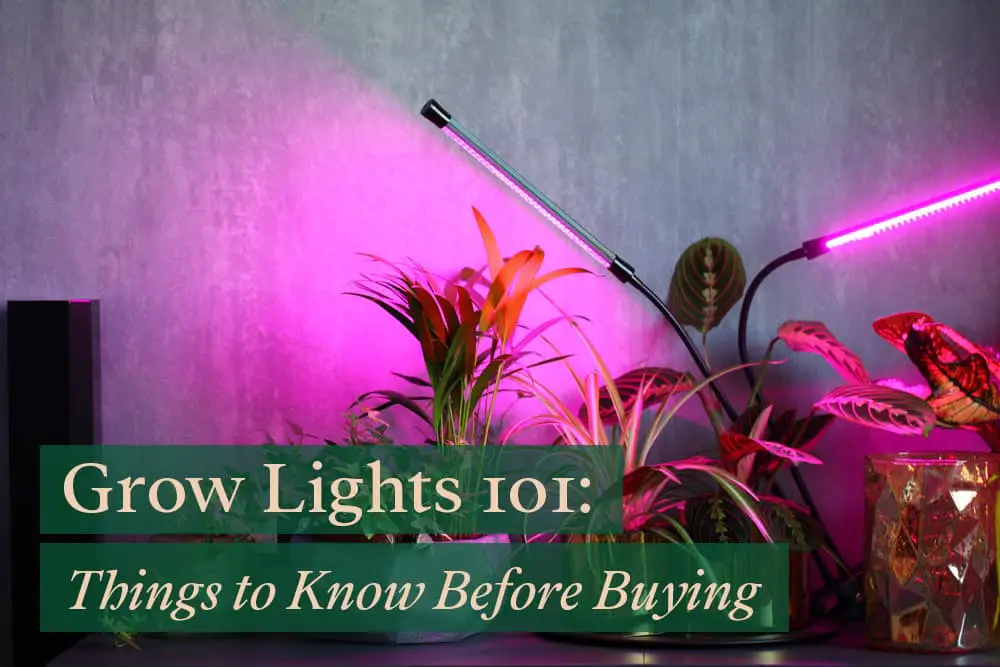
Are you thinking about buying a grow light for your houseplants but don’t know where to start? Don’t worry, it doesn’t have to be complicated! This post will guide you through everything you need to know so you can pick the best light for your plants.
When choosing the right grow lights, first, you need to know how much light does your plant need. Depending on the lit surface and light duration requirement, you can choose to buy either Incandescent, CFLs, LED or HID grow lights.
Ready to learn more about grow light? Let’s dive in!
Why Do Houseplants Need Light?
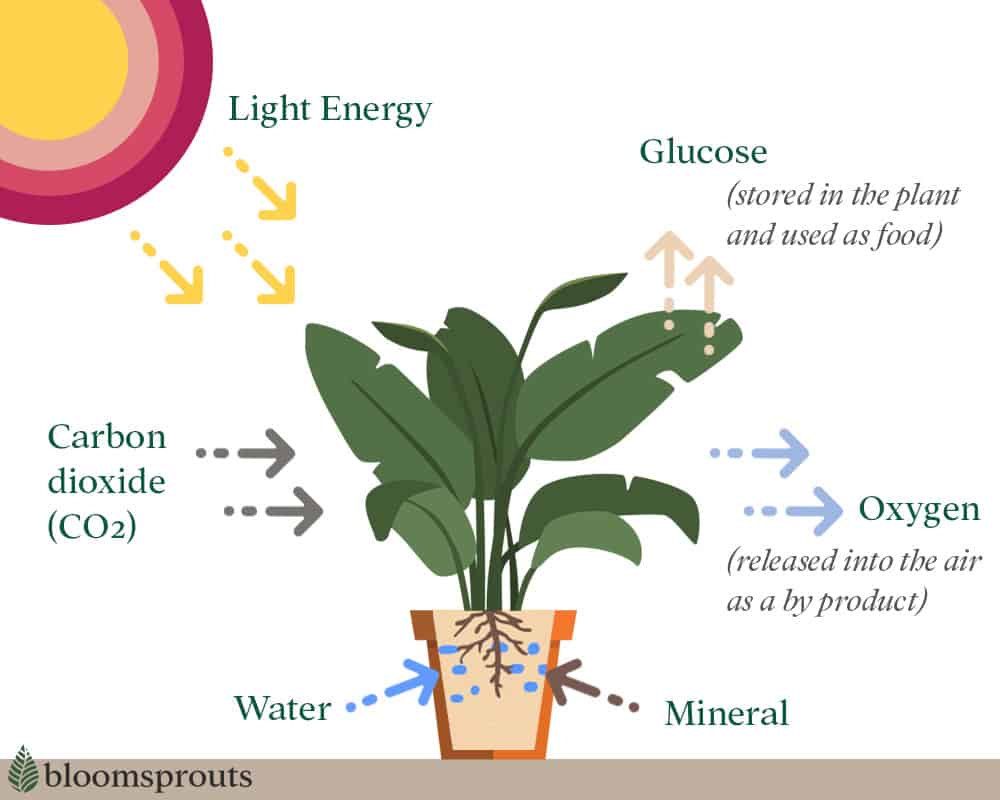
All plants require light during photosynthesis as a catalyst to convert water, minerals and carbon dioxide into oxygen and glucose. The energy stored within the glucose molecules serves as energy which fuel plants’ growth and reproduction.
Some plants need more or less light than others. For example, succulents need lots of bright light because they naturally grow in places with lots of sun.
On the other hand, something like a prayer plant or Monstera requires lower light and could actually get burned by harsh sun exposure.
Houseplants grown indoor with the low light condition will need an extra boost from a grow light. Sometimes the light from the windows is not quite enough to keep your plants growing happily.
Signs Your Houseplants Need More Light
How do you know when your plants need more light? Thankfully, there are a few signs to look out for, such as leggy growth, faded leaves, and loss of variegation (only in variegated plants).
Long Leggy Growth
Long, leggy growth, also referred to as etiolation, is your plant’s way of reaching up to try and get more light. This is very common with succulents. These plants usually have a very compact growth—their unmistakable rosettes are beautiful—but without enough light, they will grow tall and wiry and will sometimes fall over.
You may think that this tall growth is a sign of the plant growing well, but if tall growth is accompanied by the plant looking thin or weak, it is actually the opposite.
Some plants make it harder to notice etiolation than others. The key symptom to look out for is an increased distance between leaves in newer growth. Other symptoms include plant weakness (it’s more likely to fall over), longer leaves, and apical dominance—meaning the plant puts all its energy into growing up and doesn’t grow branches.
Looking again at succulents like Echeveria, these plants are sold in a healthy, compact form. That is because the nursery provides them with perfect growing conditions with lots of bright light.
Once they are brought home (or sometimes even before that, if they are being sold at a grocery store) and placed in lower-light conditions, the new, leggy growth emerging from the center of the plant will look very different from the older stem and leaves.
Faded leaves
Another sign that your plant wants more light is faded leaves. The oldest leaves may turn yellow and fall off as the plant attempts to conserve its energy. Its leaves only produce food when they are exposed to light!
Even if they aren’t turning yellow, the leaves on your plant may be fading or losing their vibrancy because the amount of chlorophyll in the leaves has gone down.
Loss of Variegation
Variegated plants are prized for their beautiful, multi-colored leaves. But if varieties like Marble Queen Pothos do not get enough light, their new leaves could come out as fully green.
This is the plant’s way of acclimating to the low-light conditions. Greener leaves mean more chlorophyll to produce more energy! It works the other way around too: When receiving adequate light conditions, your Marble Queen will produce new leaves with lots of white marbling.
Do note that old leaves will not suddenly change color to contain more or less variegation. This loss of variegation refers only to new growth.
This also does not apply to all variegated plants! Take, for example, the popular variegated Monstera, Albo Borsigiana. This cultivar’s variegation does not respond to light conditions but rather the number of mutated white cells present in the growing tip. A new leaf may emerge fully green despite getting enough light, or it may be mostly white despite growing in a darker room. It all comes down to what’s happening at the cellular level.
In general, variegated plants will need more light than their all-green counterparts because their leaves do not contain as much chlorophyll.
Factors to Consider when Choosing a Grow Light
So you’ve determined that one or more of your plants needs some extra light. Great! Now it comes down to knowing which one is right for your situation.
To do so, you should consider the light’s color spectrum, its size, its heat output, and how long you’re going to keep it on at a time.
I know that’s a lot to keep in mind! Don’t worry, we’ve got it all broken down for you here.
1. Color spectrum
Light is light, right? Well, not quite.
As you probably remember from science class, white light is composed of all the visible spectrum colors. Plants do not absorb all of those light frequencies. Specifically, they do not absorb most of the green light; instead they reflect it, which is why they look green to our eyes.
The two-color frequencies that plants benefit the most from are red and blue. That’s why some grow light setups have an intense purple light, especially if the plants are being grown for commercial purposes.
Grow lights come in blue/red as well as full-spectrum white. There are pros and cons to both, and you will have to choose which is best for your situation.
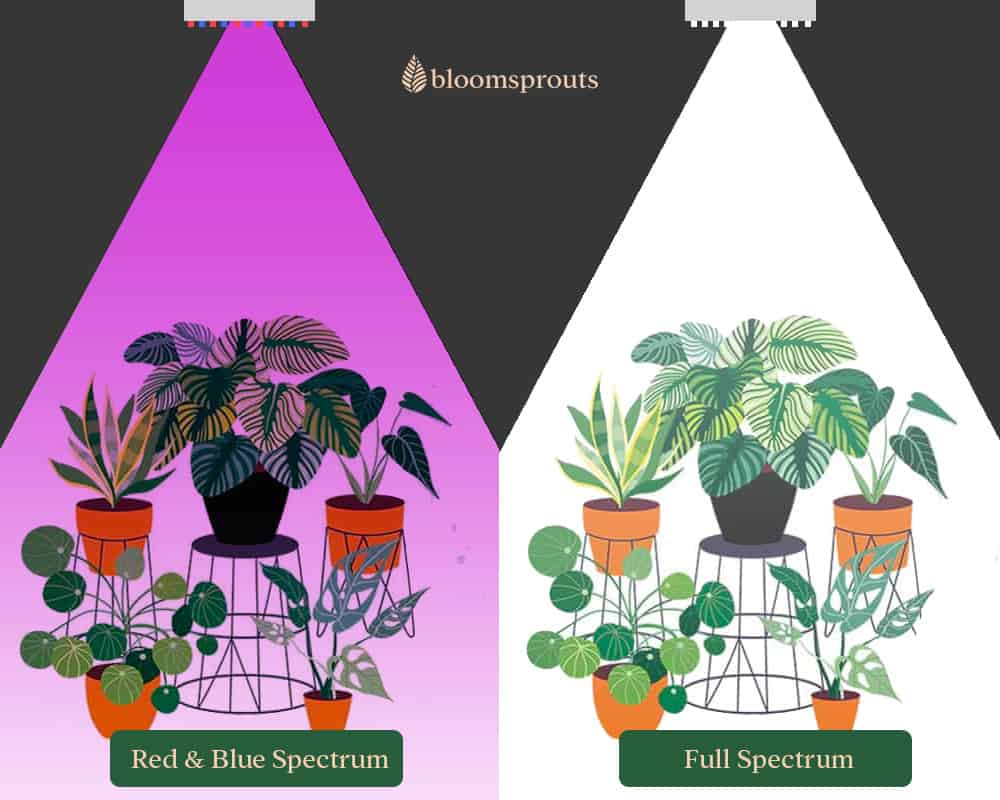
Blue and Red
Blue light and red light are both good for your plant. Each of these colors provides a different benefit. Some plants may need a higher percentage of red light or vice versa.
So what do red and blue lights do for your plant?
Blue light is related directly to chlorophyll production. Plants that receive lots of blue light will have healthy leaves and stems. This prevents the plant from becoming etiolated and leggy. All plants will benefit from blue light.
Blue light also promotes darker, healthier color in plants’ leaves and stems. If low light causes faded leaves, a blue light would bring the color back!
Red light stimulates plant growth, and it benefits flower and fruit production. Its importance in building biomass means that red light is useful for younger plants in getting established. Using only red light will cause plants to grow vigorously, but they will be stretched out, long, and weak.
Red/blue grow lights come in different ratios; some will have more or less red light. Your choice will ultimately depend on how much you want your plant to grow and whether or not you want it to flower or produce fruit.
Full Spectrum
A full spectrum grow light may be a better option if you don’t like how the red and blue lights look. This grow light will appear white to the human eye, but don’t worry, as it still contains plenty of blue and red light to keep your plants happy.
Full-spectrum lights are great because they are stealthy! You can sometimes even put them in a regular lamp so that you and your plants both benefit from the light.
2. Lit Surface
How many plants are you trying to grow under a light?
Grow lights range in size from a single bulb to a meters-long fluorescent array hung from the ceiling—and everything in between!
If you only have one small plant, you will only need one small light, perhaps a fixture you can clip to the side of your desk or table.
However, if you have multiple plants or one that is quite large, you would need to consider a larger light or perhaps multiple smaller lights to work together.
3. Heating output
It is important to consider how much heat is going to be produced by the lights. Some bulbs may produce more heat than others.
Placing a cooler bulb (like you will find with LED lights) closer to your plant, able to provide more light without risking giving your plant a sunburn.
On the other hand, hotter bulbs can also pose a hazard; they can become hot to the touch when left on for too long. Also, the energy that the bulb transfers into heat ends up being wasted and just makes the light more expensive to run.
4. Time of use
When choosing a new grow light, you should think about how long you will need to run it every day. Some grow lights have a timer, a handy function to make sure they get turned off on time.
If your plants already get some sunlight from the window, you can cut back the time your grow light is on and use it as a supplement for when the sun isn’t shining.
So how much light do plants really need?
In general, plants need between 12 and 16 hours of light. However, just like different plants require either brighter or lower light, some plants need light for more or fewer hours each day.
Long-Day plants need a full 16 hours of light daily, while Short-Day plants may need as few as 10 hours. Lots of succulents, for example, are long-day plants. Long days with bright light allow these hardy plants to thrive and even flower. A popular short-day plant is the Christmas cactus, which only blooms when the days grow shorter in the winter.
Then some plants are day-neutral, which do not react to day length to determine when they bloom. They do well with 12 hours every day.
Ultimately, you will have to do some research to determine your plants’ day length preference, so you know how long to keep their lights on!
Grow Light Options
Now that you know what qualities your grow light needs for your situation, let’s look at the different kinds of forms these lights can take. There are four main kinds of bulbs used for grow lights: incandescent, compact fluorescent (CFL), LED, and HID.
Let’s look at each of these options so you can choose the best one for your plants.
Incandescent Lights
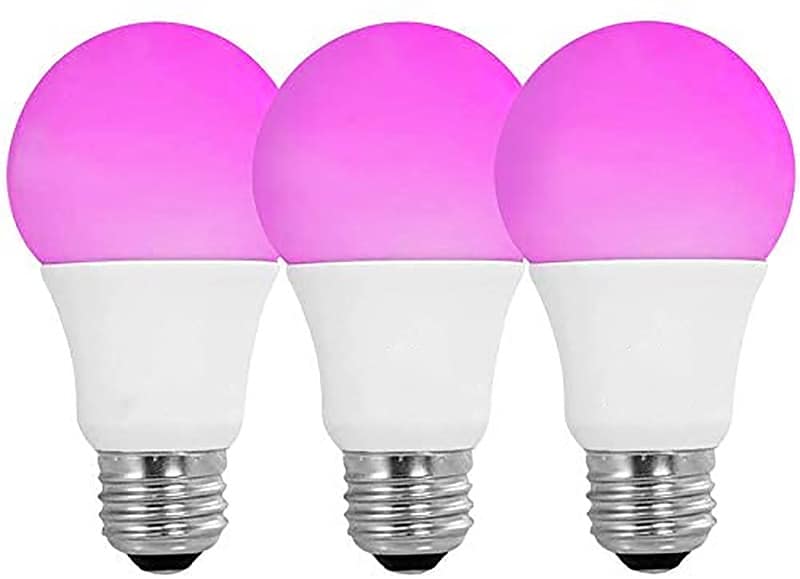
When you think of a light bulb, you probably imagine an incandescent light. This is the original form of electric light invented by Thomas Edison where electricity passes through a filament, causing it to glow brightly.
Incandescent grow lights are great if you don’t need light for a lot of plants. They fit in a standard light socket so that you can place them in a stylish lamp. They are also relatively inexpensive, costing about $7.
The downside of using an incandescent grow light is the amount of heat it can produce. If the light is placed too close to your plant’s leaves, it could cause them to burn.
This heat production also means that incandescent bulbs use more energy than their modern counterparts. There is a reason why LED lights have become so popular lately; incandescents cost more money to keep on, especially for something like a grow light that will be running most of the day.
Pros:
- Cheap to buy
- Fit in a standard light socket
Cons:
- Often produce too much heat which may cause burn on leaves
- Use more energy, thus more expensive to operate
Compact Fluorescent Lights (CFLs)

Compact fluorescent bulbs, or CFLs for short, are the next step up from incandescent. They were initially developed to be a more efficient and longer-lasting replacement for traditional incandescent bulbs.
CFLs do not produce nearly as much heat, they require less electricity to run (but emit the same light levels), they are less expensive, and they come in various forms.
Fluorescent lights provide a good amount of flexibility when determining your grow light setup. You can find CFLs that fit in a standard light fixture as well as longer bulbs that you might see in an industrial indoor growing operation.
The light from CFLs will always be full spectrum. There is no way to make a red or blue CFL. However, they range from warm light with more red tones to cool light, containing more blue tones.
Pros:
- Even cheaper to buy
- Fit in a standard light socket
- Produce less heat compared to incandescent lamp
- Need less electricity to run
Cons:
- Only available in full-spectrum option
Light Emitting Diode (LED) Lights
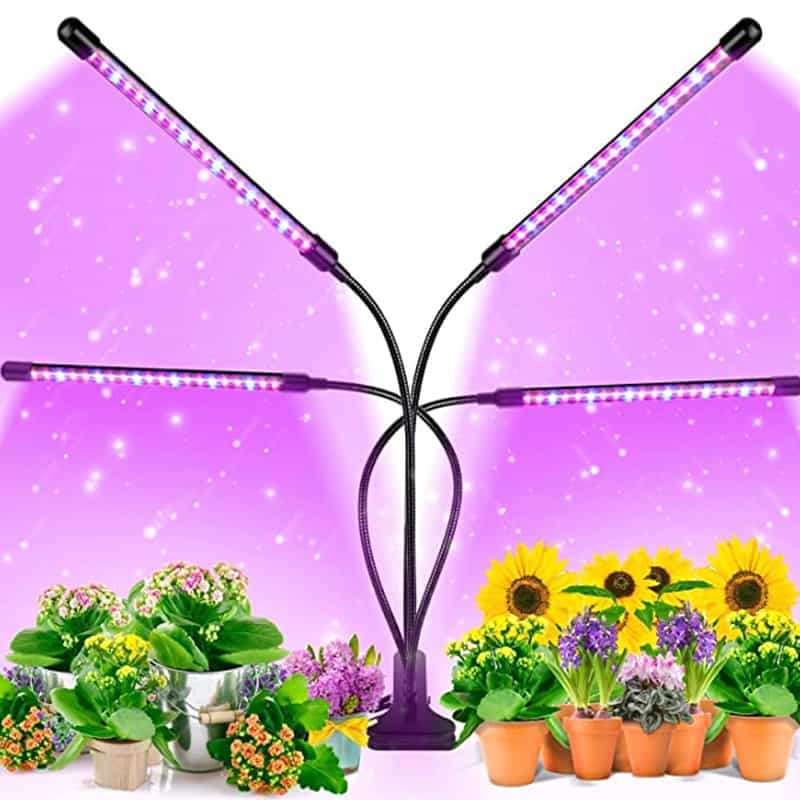
LEDs, or light-emitting diodes, are an even newer invention than fluorescent lights. They use a minimal amount of electricity, and they stay cool even if you leave them on for a long time. Because of their low energy cost, LED lights have become very popular to use around the house.
They are especially useful for producing a specific color of light. This comes in handy for grow lights! If you want red and blue grow lights for your plants, you will need to look for LED setups. Some even allow you to adjust the red:blue ratio based on your plants’ needs.
These come in various sizes and setups, similar to what you will find with CFLs but with even greater specialization. LED grow lights come as standard size bulbs, as standalone lamps (some with multiple arms to reach multiple plants at once), and as hanging overhead installations.
Overall, LEDs will be the most versatile option for you and your houseplants, and they will give you the best value for your money spent.
Pros:
- Stay cool even after extended use
- Able to find specific red:blue ratio option
- Energy efficient
- Fit in a standard light socket
Cons:
- More expensive to buy
High-Intensity Discharge (HID) Lights
There is one last kind of light used for plants: the HID light. This stands for high-intensity discharge. These lights are used mostly in commercial growing situations.
A HID light setup includes a superbright gas bulb with a reflective shield behind it to concentrate the light down onto the plants.
HID lights can provide red or blue wavelengths based on the gas used in the bulb. Unlike with LED lights, this is not adjustable. You have to know ahead of time exactly what kind of light your plants need to produce your desired outcome.
Because of their size and cost, these are not practical for use in the home. Your standard houseplants will not need this level of intensity. However, if you intend to grow anything for commercial purposes or have a large hydroponics setup, they may be a good option.
Pros:
- Able to concentrate light to plants
- Available in large sizes – for commercial or large hydroponics setup
Cons:
- Expensive to buy
- Need larger energy – more expensive to run
How to Use Grow Lights Effectively
How do you know you’re using the grow lights properly? Your plant may not show any immediate changes, so follow these recommendations to make sure you’re doing it right.
Where to place your grow light
| Grow Light types | Min. Distance from plants |
|---|---|
| Incandescent | 24 inches (60 cm) |
| Compact Fluorescent Lights (CFLs) | 12 inches (30 cm) |
| Light Emitting Diode (LED) | 6 inches (15 cm) |
| High-Intensity Discharge (HID) | 12 inches (30 cm) |
Your grow light needs to be very close to the plant’s leaves to be useful. Light intensity decreases exponentially the further away you go from the source. Putting a grow light in the ceiling, for example, will transfer no benefit to a houseplant on the floor.
Incandescent grow light bulbs should be at least 24 inches over your plants. Fluorescent and LED lights have a lower heat signature, so they can be placed 12 and 6 inches over plants respectively.
You want to place Fluorescent and LED grow light at least 12 inches (30 cm) over your plants. Incandescent lights with a higher heat signature should be placed at least 24 inches away. You will need to place the light closer for flowering and fruiting plants and place it further away for leafy plants.
In general, cooler bulbs like CFLs and LEDs can be placed closer to the leaves because they are less likely to burn the plant. Incandescent bulbs will need to remain a little farther away.
When in doubt, follow the manufacturer’s recommended distance.
It is better to start a little further away and then inch closer little by little every day. When the leaves begin to turn slightly pale from the light (signs of minor sunburn), pull the light back a few inches. This way, your plant is getting as much light as possible without getting burned.
How long to keep them on
It would be best to run the grow lights as long as it takes to make sure your plants get about 12 hours of light every day. This could mean running the light for a full 12 hours.
Alternatively, if your plants are already near a sunny window, you could run the light in the morning before the sun comes up and again in the evening after it goes down. This is especially relevant in the winter when the days are short.
Remember that some plants require long days—up to 16 hours of light—to thrive and bloom, while others need short days, as few as 10 hours of light.
Some grow lights come with a timer function so you can make sure your plants don’t get too much or too little light. A timer enables you to provide consistency for your plants.
If the light doesn’t come with a built-in timer, you can buy one that plugs in between the lamp and the outlet. These are commonly used for Christmas lights and decorations, so while they are available at the hardware store year-round, they may be easier to find in December.
My Recommended Grow Light
Budget
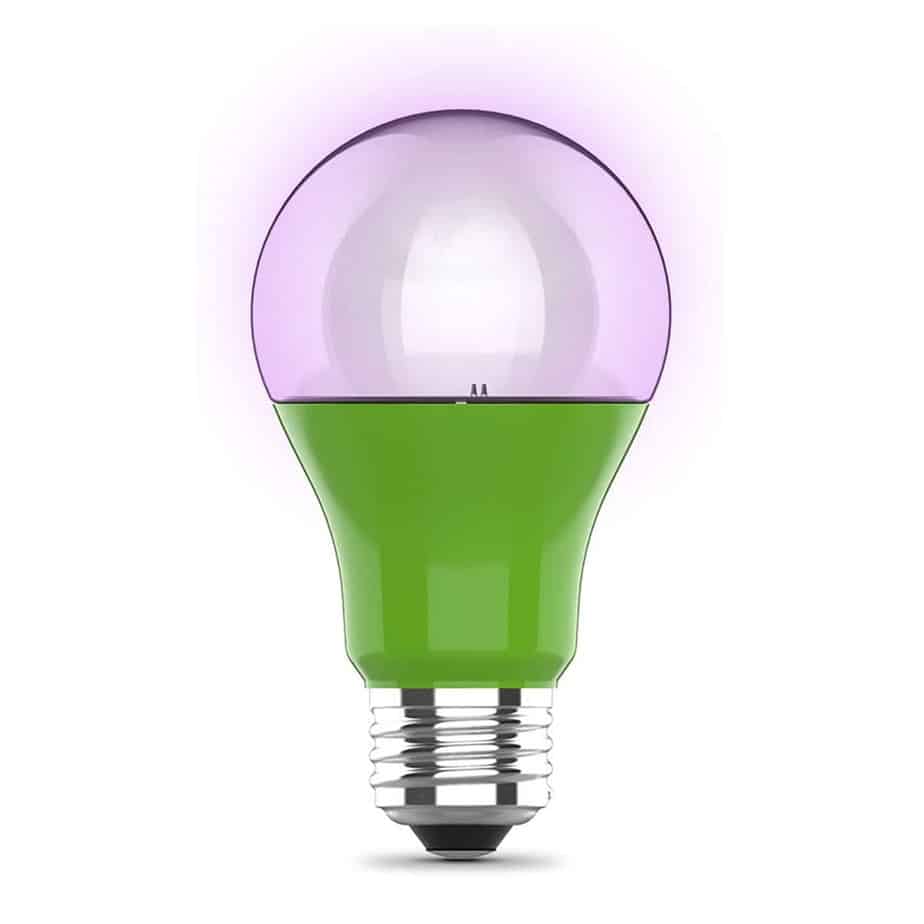
If you’re just getting started with grow lights, you probably don’t want anything too big or difficult to set up. I recommend starting with a standard-size bulb that can be put in a desk lamp you may already have.
A great budget option here is this LED bulb made by Feit Electric. This is a full-spectrum LED light that has red and blue wavelengths included in it. It has a standard E26 base, which means it will easily fit in the most common light socket size.
For only $10, this is my go-to grow light for single plants. I like to keep succulents on my computer, and this light has kept them looking beautiful, colorful, and compact!
Best Value
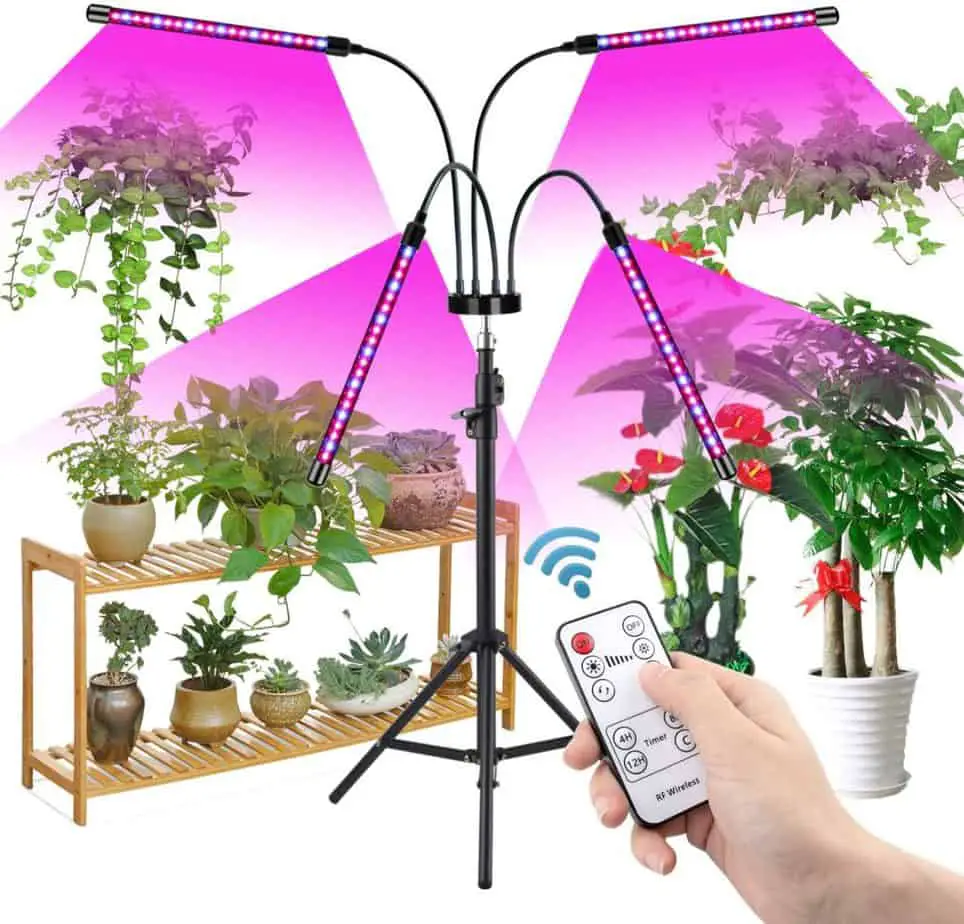
If you need a larger system for more plants, I highly recommend this grow lamp by Growstar. For $55, you get a lot of value with this lamp. It has four lights at the end of flexible arms, so you can turn the light to face multiple plants at once. Its main stand is adjustable and can reach plants up to six feet (two meters) tall.
The LED lights in each arm come in red and blue, and you can switch between all red, all blue, and full-spectrum with the press of a button. It is also dimmable, with nine brightness settings.
Most importantly (for me at least), it has a timer. You can set it to run for 4, 8, or 12 hours at a time. This makes it very easy to take the best care of your houseplants.
This option is the best value for houseplants because of its easy-to-use features. I found it super easy to assemble and set up the day it arrived. It is not as bright as some other options, like the HID lights, but this is not a problem for my houseplants.
Related Questions:
Can grow light burn my houseplants?
Grow lights should not burn your houseplants if appropriately used. However, leaf burn can become an issue if you place the lights too close to your plants.
Before using your new grow light, you must check to see its recommended distance from the leaves. A more powerful light is more likely to burn a plant’s leaves and need to keep farther from a less powerful light.
If you think your grow light has burned your plant’s leaves, move the light further away as soon as you can. Burned leaves will hurt the plant’s ability to produce energy (you know, the whole point of using a grow light in the first place) as well as its ability to regulate water and air levels. Too many burned leaves can kill a plant quickly.
When in doubt, it is better to start with the grow light further away from the plant, and slowly introduce more intense light over the span of a week or so. Especially if the plant was previously in very low light conditions, it will need some time to get used to the intense change.
Does grow light give off radiation?
All light is technically considered radiation, as it consists of waves radiating from a source. Of course, some frequencies are more dangerous to us than others.
The visible spectrum, red through purple, are not damaging to humans. Once you go past blue and purple light, however, you find ultraviolet light. UV light is what causes your skin to become damaged when spending too much time in the sun.
Some grow lights do include ultraviolet wavelengths, as they have been shown to provide some benefit to plants. This would not be enough UV light to pose any risk to people in the same room near the light.
Dangerous wavelengths, such as X– or gamma-rays, are not produced by grow lights. These lights provide only a very narrow range of light wavelengths to provide specific benefits to the plant.
